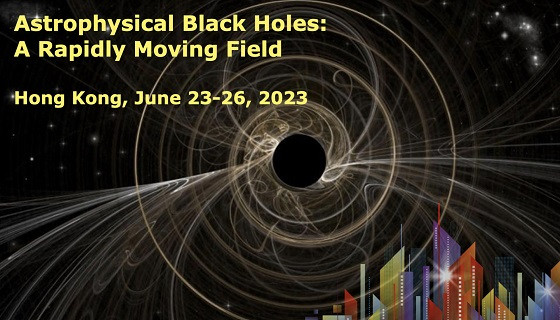Session:- Black hole physics in the EHT era
Theoretical and observational studies of astrophysical black holes have been in rapid development in recent decades. This conference will present major breakthroughs and key remaining questions concerning our fundamental understanding of astrophysical black holes, such as the formation and collimation of relativistic jets, the accretion and growth of black holes, the measurement of black hole spin, the merger of black holes, the first images of black hole shadow, the particle acceleration mechanisms and transient phenomena around black holes, and the feedback from massive black holes to galaxies.
◎Connecting the branches to the roots: confronting long-standing questions about jet physics in the global VLBI/EHT era
Black hole jets are a challenging puzzle, as they require insights over a range of scales impossible to capture with any one method. Somehow effects playing out at galactic scales are rooted in microphysical processes occurring just outside an event horizon, that somehow also determine the formation of special regions where particle acceleration preferentially occurs. Thanks to global Very Long Baseline Interferometry(VLBI) projects like the Event Horizon Telescope(EHT) and Global mm-VLBI Array(GMVA), the research team is finally gaining access to regions they could only dream of directly imaging decades ago when many key questions were formulated about jets. But high-precision imaging is not enough to break the many degeneracies inherent in the models. In this talk the speaker will review recent progress where precision VLBI imaging, in combination with new multi-wavelength constraints and modelling techniques, is helping to address a range of questions regarding accretion physics and geometry, jet launching, and the origin of high-energy flares. She will also discuss the prospects as we move into an era of dynamical imaging as well as more sensitive high-energy facilities such as the Cherenkov Telescope Array.
時間:2023.06.24(六) 14:00~14:35
講者:Prof. Sera Markoff
↓
↓
◎A Closer Look: Modeling Emission in M87 Down to the Horizon-Scale with Positrons
With the advent of sub-mm imaging of black hole shadows by the Event Horizon Telescope starting in 2019 with M87*, the research team is now in a position to infer physical mechanisms powering systems such as M87 (including its relativistic jet) down to the horizon-scale using phenomenological models. First, a self-similar, stationary, axisymmetric jet model based on a force-free flow in a High Accuracy Relativistic Magnetohydrodynamics(HARM) jet simulation is used to generate Stokes maps at Very Long Baseline Array(VLBA, 43 GHz) and Event Horizon Telescope(EHT, 230 GHz) scales– varying plasma content from ionic (e-p) to pair (e⁻e⁺). Emission at the observed frequency is assumed to be synchrotron radiation from electrons and positrons, whose pressure is set to be constant fractions of the local magnetic pressure. The cleanest observational signatures predicted are the vanishing of intrinsic circular polarization in V/I maps and in polarized spectra for positron-rich jets. Positrons are then incorporated into the general relativistic ray tracer IPOLE to display positron effects in HARM simulations within ~10 gravitational radii from the black hole. Models of magnetized plasma in the M87 Jet/Accretion flow/Black hole(JAB) system based on turbulent heating and deviations from the equipartition of particle and magnetic energies reveal a stark dichotomy in polarization signatures between Standard And Normal Evolution(SANE) and Magnetically Arrested Disk(MAD) accretion modes due to positron-modulated Faraday effects. The inclusion of electrons, positrons and protons in our radiative transfer pipeline thus provides a powerful probe of the composition of JAB systems.
時間:2023.06.24(六) 14:35~15:10
講者:Prof. ANANTUA, Richard (University of Texas at San Antonio)
↓
↓
◎A Black Hole Closeup: Enhancing Black Hole Science with the ngEHT and Space
After over a century since their initial mathematical description, black holes and their surroundings remain poorly understood. In April 2019, the Event Horizon Telescope released the first image of a black hole, bringing the nature of physics at horizon scales into focus. This talk will detail how additional telescopes will enhance fainter features of black holes, their surrounding environment, and sharpen our understanding of gravitational physics near the event horizon. Adding additional ground telescopes will allow the next-generation Event Horizon Telescope to see closer to the horizon, measure its properties, and create black hole cinema. These movies will enable direct studies of the dynamics of accretion and the conditions of jets near the horizon. Furthermore, the addition of a space telescope will further focus on the role of gravity, creating the highest-resolution images ever produced and enabling new tests of general relativity.
時間:2023.06.24(六) 15:10~15:45
講者:Prof. TIEDE, Paul (CfA, Harvard & Smithsonian)
↓
↓
◎Investigating jet physics via the joint modelling of Event Horizon Telescope images and multi-wavelength observations
A key characteristic of some Active Galactic Nuclei(AGN), such as radio galaxies, is that they possess powerful jets that can extend through or beyond their host galaxy. However, the exact mechanisms of their launch and their internal properties are still not well understood. In this talk, the speaker will focus on Event Horizon Telescope(EHT) and multi-wavelength image and spectral observations of our neighbouring AGN, M87. In particular, she investigates what processes are responsible for the particle acceleration physics by calculating the electron Distribution Function(eDF), as well as interpreting the resultant images and spectrum, to explore the origins of the observed jet power. Once a certain eDF choice is made, it is important that the observed emission is interpreted thoroughly because the process in which these simulated images are created has consequences for the overall spectrum. There is a degeneracy in the simulation process because her research team does not calculate the eDFs from first principles but rather explore preset parameterised eDFs based on Particle-In-Cell(PIC) simulations that consist of more accurate plasma physics simulations. In this talk, the speaker will present an optimisation and fitting pipeline for simulating images of M87 and simultaneously compare them to 2017 multi-wavelength data published by the EHT multi-wavelength group. This pipeline will be used in future EHT and multi-wavelength studies.
時間:2023.06.24(六) 15:45~16:03
講者:MULAUDZI, Wanga (Anton Pannekoek Institute for Astronomy)
↓
↓
地點:香港大學 百週年校園 CPD 3.04 Centennial Campus
語言:英語
是會議作坊,參加者必須登記,2023.04.30 截止
【此屬轉載訊息,以主事單位發佈為準】
此活動由香港大學物理系主辦。
https://astrobh.physics.hku.hk/event/3/timetable/#all.detailed


